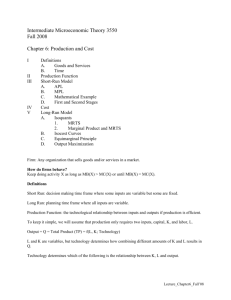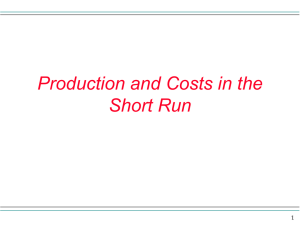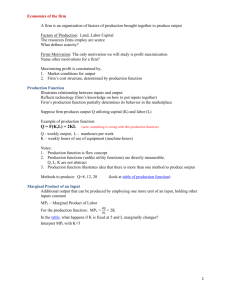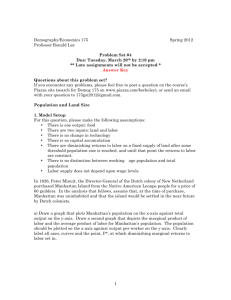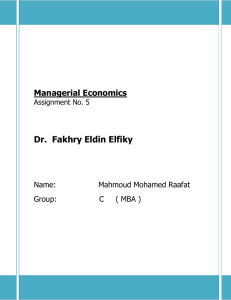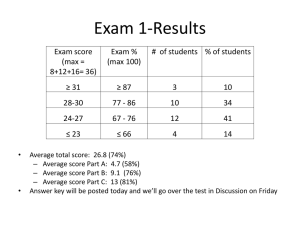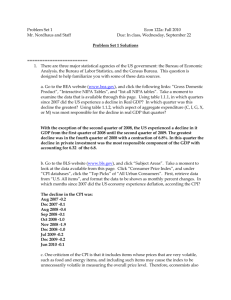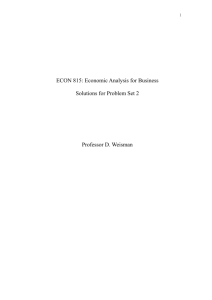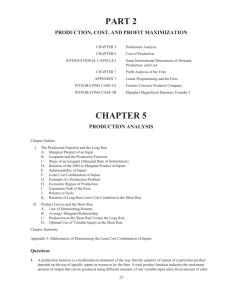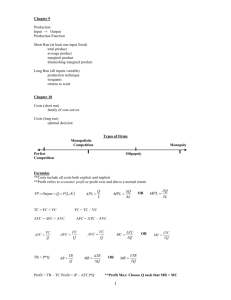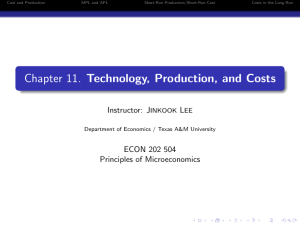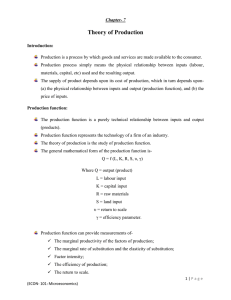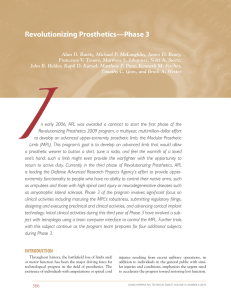Advanced version
advertisement
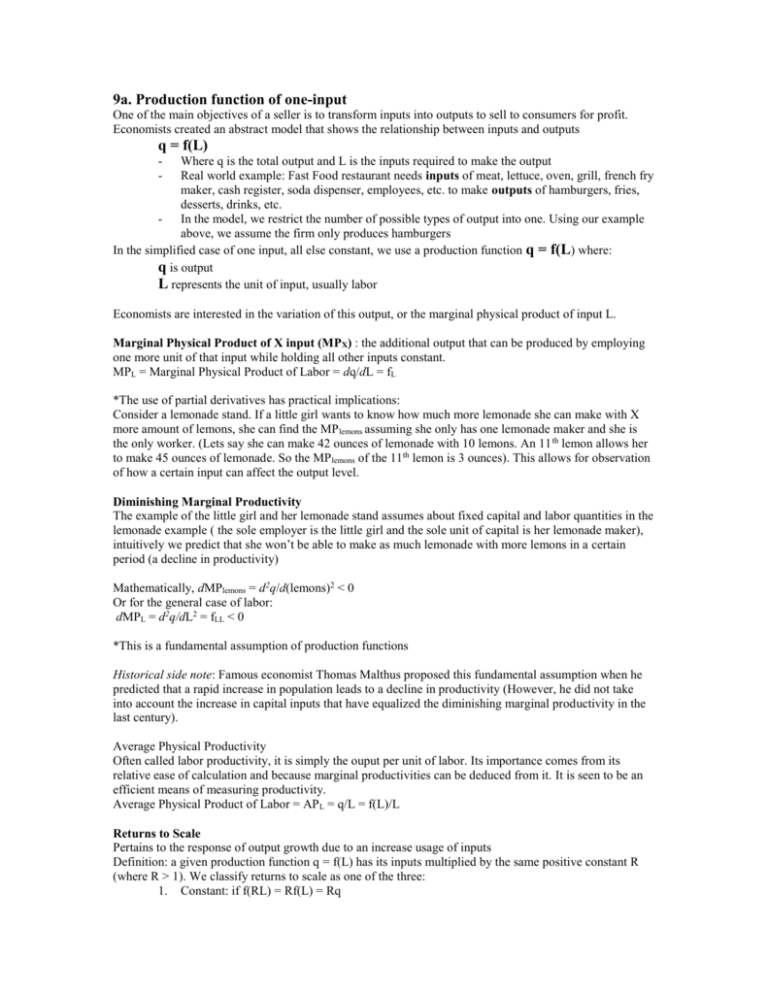
9a. Production function of one-input
One of the main objectives of a seller is to transform inputs into outputs to sell to consumers for profit.
Economists created an abstract model that shows the relationship between inputs and outputs
q = f(L)
-
Where q is the total output and L is the inputs required to make the output
Real world example: Fast Food restaurant needs inputs of meat, lettuce, oven, grill, french fry
maker, cash register, soda dispenser, employees, etc. to make outputs of hamburgers, fries,
desserts, drinks, etc.
- In the model, we restrict the number of possible types of output into one. Using our example
above, we assume the firm only produces hamburgers
In the simplified case of one input, all else constant, we use a production function q = f(L) where:
q is output
L represents the unit of input, usually labor
Economists are interested in the variation of this output, or the marginal physical product of input L.
Marginal Physical Product of X input (MPX) : the additional output that can be produced by employing
one more unit of that input while holding all other inputs constant.
MPL = Marginal Physical Product of Labor = dq/dL = fL
*The use of partial derivatives has practical implications:
Consider a lemonade stand. If a little girl wants to know how much more lemonade she can make with X
more amount of lemons, she can find the MP lemons assuming she only has one lemonade maker and she is
the only worker. (Lets say she can make 42 ounces of lemonade with 10 lemons. An 11 th lemon allows her
to make 45 ounces of lemonade. So the MP lemons of the 11th lemon is 3 ounces). This allows for observation
of how a certain input can affect the output level.
Diminishing Marginal Productivity
The example of the little girl and her lemonade stand assumes about fixed capital and labor quantities in the
lemonade example ( the sole employer is the little girl and the sole unit of capital is her lemonade maker),
intuitively we predict that she won’t be able to make as much lemonade with more lemons in a certain
period (a decline in productivity)
Mathematically, dMPlemons = d2q/d(lemons)2 < 0
Or for the general case of labor:
dMPL = d2q/dL2 = fLL < 0
*This is a fundamental assumption of production functions
Historical side note: Famous economist Thomas Malthus proposed this fundamental assumption when he
predicted that a rapid increase in population leads to a decline in productivity (However, he did not take
into account the increase in capital inputs that have equalized the diminishing marginal productivity in the
last century).
Average Physical Productivity
Often called labor productivity, it is simply the ouput per unit of labor. Its importance comes from its
relative ease of calculation and because marginal productivities can be deduced from it. It is seen to be an
efficient means of measuring productivity.
Average Physical Product of Labor = AP L = q/L = f(L)/L
Returns to Scale
Pertains to the response of output growth due to an increase usage of inputs
Definition: a given production function q = f(L) has its inputs multiplied by the same positive constant R
(where R > 1). We classify returns to scale as one of the three:
1. Constant: if f(RL) = Rf(L) = Rq
2.
3.
Decreasing: if f(RL) < Rf(L) = Rq
Increasing if f(RL) > Rf(L) = Rq
Historical side note: Adam Smith studied the notion of increasing scales of production with pins. He
noticed that doubling a scale of production promoted greater division of labor (increased specialization).
So, there is reason to believe that there will be an increase in efficiency. However, there was also reason to
assume a loss in efficiency as a result of doubling the amount of inputs since management would have a
hard time overseeing a larger scale firm. A naturally arising question is which of the two tendencies had the
greater effect.
Study Questions
1. for a production function q = 10L2 - 4L3, find
a. the MPL
b. the point at which MP L is 0
2. When the MPL is rising, does this mean that the APL is also rising?
3. When the MPL is falling, does this mean that the AP L is also falling?
4. When is the MPL = APL?’
5. Management learns that hiring a new workforce equal in number to the existing workforce
(doubling the workforce) without purchasing new equipment or any other form of capital has
doubled the output for the firm. Does this scenario seem plausible?
6. A toaster company notices that having 5 workers in the manufacturing sector produces an output
of 30 toasters. However, hiring after hiring a 6 th worker, the firm produces 38 toasters. What is the
MPL of the 6th worker? The APL? Assuming that the 6th worker isn’t a super-employee, what are
some possible reasons for the heightened scale of production?
7. Suppose q = BLa. What must B and a be in order for the fundamental assumptions of production
functions to hold?
8. The MPL of a firm is 30/L. 5. What is the production function? (Hint: use calculus of integration)
Answers:
1a. MPL = dq/dL(10L2 - 4L3) = 2(102-1) – 3(4L3-1) = 20L – 12L2
1b. solve MPL = 0: 20L – 12L2 = 0
factor out 4L: 4L(5 – 3L) = 0
two solutions: at L = {0, 5/3}
2. Yes. As long as MP L > APL, the APL is rising. This is because MPL is always greater than APL
when it is still rising.
3. Not necessarily. Since MP L experiences diminishing marginal returns, it slowly starts to
decrease. Since APL only rises when MP L is greater than AP L, this implies that even when MPL is
decreasing, APL may still be rising.
4. MPL = APL when APL stops rising. After MPL reaches its maximum point, the decreasing
MPL begins to drag the average down with it. At this point when MP L has already started to
fall, it catches up with APL when the slope of AP L = 0, or when it is at its maximum point.
5. The scenario is only plausible if the firm was working at an inefficiently low level prior to the
new mass hiring or they learned how to increase their efficiency through specialization and
division of labor. Otherwise, due to diminishing marginal productivity, the scenario is
impossible.
6. The MPL is 8 toasters. The APL is a 38/6 = 6.33 toasters per worker. Some possible reasons
for the increase in marginal productivity is there may be an increase in output due to a
division of labor and consequent specialization. Since the operation is relatively small in
scale, management can still oversee the operation and do its job. (For review, read the
historical side note regarding Adam Smith and the pin factory).
7. In order for the fundamental assumptions of production functions to hold, d2q/dL2 must be
negative. So B is any positive real number since a constant doesn’t affect the second
derivative of a production function. For a,
dq/dL = aBLa-1
d2q/dL2 = a(a-1)Ba-2 < 0
Expanding the terms, we see that the inequality becomes (a 2 – 1)BLa-2 < 0
As long as a >1, the inequality holds.
8.
the integral of MP L is int(dq/dL) =q + C.
Thus, int(30/L. 5) = 30L-. 5+1/(-. 5 +1) + C = 60L. 5 + C
